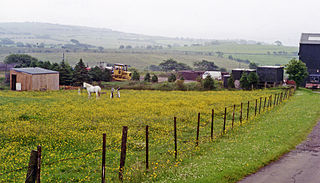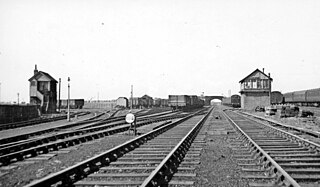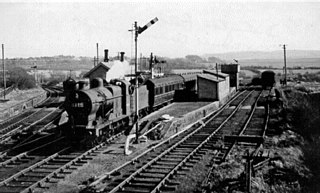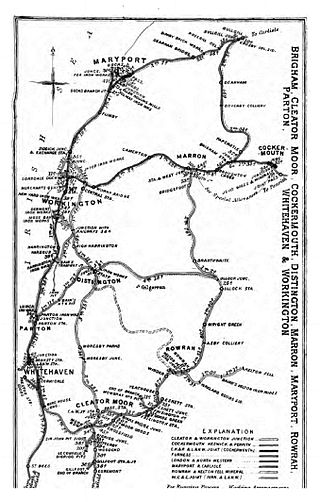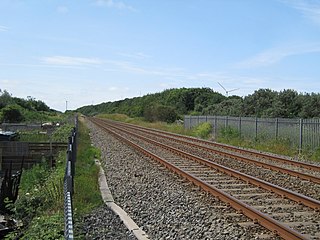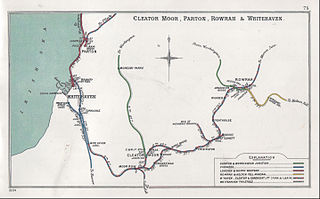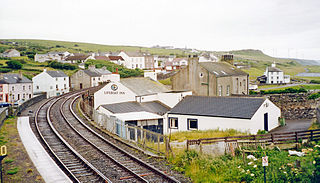Lowca | |
|---|---|
 Lowca's 1st station in the colliery yard, probably on 2 June 1913 | |
| General information | |
| Location | Lowca, Cumbria England |
| Coordinates | 54°34′54″N3°34′51″W / 54.5817°N 3.5808°W |
| Grid reference | NX979218 |
| Platforms | 1 [1] [2] |
| Other information | |
| Status | Disused |
| History | |
| Original company | Bain's Mineral Railway |
| Pre-grouping | Harrington and Lowca Light Railway |
| Post-grouping | Harrington and Lowca Light Railway |
| Key dates | |
| 15 April 1912 | Workmen's service commenced |
| 2 June 1913 | Public passenger service [3] |
| 31 May 1926 | Public passenger service ended |
| 1 April 1929 | Workmen's service ended [4] |
Lowca Light Railway and Gilgarran Branch | ||||||||||||||||||||||||||||||||||||||||||||||||||||||||||||||||||||||||||||||||||||||||||||||||||||||||||||||||||||||||||||||||||||||||||||||||||||||||||||||||||||||||||||||||||||||||||||||||||||||||||||||||||||||||||||||||||||||||||||||||
|---|---|---|---|---|---|---|---|---|---|---|---|---|---|---|---|---|---|---|---|---|---|---|---|---|---|---|---|---|---|---|---|---|---|---|---|---|---|---|---|---|---|---|---|---|---|---|---|---|---|---|---|---|---|---|---|---|---|---|---|---|---|---|---|---|---|---|---|---|---|---|---|---|---|---|---|---|---|---|---|---|---|---|---|---|---|---|---|---|---|---|---|---|---|---|---|---|---|---|---|---|---|---|---|---|---|---|---|---|---|---|---|---|---|---|---|---|---|---|---|---|---|---|---|---|---|---|---|---|---|---|---|---|---|---|---|---|---|---|---|---|---|---|---|---|---|---|---|---|---|---|---|---|---|---|---|---|---|---|---|---|---|---|---|---|---|---|---|---|---|---|---|---|---|---|---|---|---|---|---|---|---|---|---|---|---|---|---|---|---|---|---|---|---|---|---|---|---|---|---|---|---|---|---|---|---|---|---|---|---|---|---|---|---|---|---|---|---|---|---|---|---|---|---|---|---|---|---|---|---|---|---|---|---|---|---|---|---|---|---|---|
| ||||||||||||||||||||||||||||||||||||||||||||||||||||||||||||||||||||||||||||||||||||||||||||||||||||||||||||||||||||||||||||||||||||||||||||||||||||||||||||||||||||||||||||||||||||||||||||||||||||||||||||||||||||||||||||||||||||||||||||||||
| ||||||||||||||||||||||||||||||||||||||||||||||||||||||||||||||||||||||||||||||||||||||||||||||||||||||||||||||||||||||||||||||||||||||||||||||||||||||||||||||||||||||||||||||||||||||||||||||||||||||||||||||||||||||||||||||||||||||||||||||||
1972 | ||||||||||||||||||||||||||||||||||||||||||||||||||||||||||||||||||||||||||||||||||||||||||||||||||||||||||||||||||||||||||||||||||||||||||||||||||||||||||||||||||||||||||||||||||||||||||||||||||||||||||||||||||||||||||||||||||||||||||||||||
| ||||||||||||||||||||||||||||||||||||||||||||||||||||||||||||||||||||||||||||||||||||||||||||||||||||||||||||||||||||||||||||||||||||||||||||||||||||||||||||||||||||||||||||||||||||||||||||||||||||||||||||||||||||||||||||||||||||||||||||||||
| ||||||||||||||||||||||||||||||||||||||||||||||||||||||||||||||||||||||||||||||||||||||||||||||||||||||||||||||||||||||||||||||||||||||||||||||||||||||||||||||||||||||||||||||||||||||||||||||||||||||||||||||||||||||||||||||||||||||||||||||||
Lowca had two railway stations that served the village of Lowca in the former county of Cumberland, England, which is now part of Cumbria. [5] [6]
Contents
The line was originally a waggonway that conveyed coal from a drift mine at Lowca to Harrington Harbour and later to Harrington Iron Works. As the demand for greater quantities of coal to feed the ironworks was most important new mines with vertical shafts were sunk. These were named after the parent ironworks and took the name of Harrington with a shaft number to identify them, such as Harrington No.4 and Harrington No.9.
A public passenger service ran from the 1st station between 2 June 1913 and when the 2nd Lowca Station was completed in August 1913 public services ran until they ceased in May 1926. Unadvertised workmen's trains had started in April 1912 and ran between Moss Bay Cart Siding and the colliery station in the pit yard. After the Light Railway order ended the private workmen's service continued until April 1929, after which the workmen's trains ceased.
By 1922 the service had settled down to three trains each way between Lowca and Workington Central, with an extra on Saturdays. There never was a public Sunday service. [7]
The first station at Lowca was built by Bain & Co. who owned the colliery and Harrington Ironworks. It was situated in the colliery yard and was closed to public passenger use when the second station at Lowca was opened in August 1913.
The second station was on the Harrington and Lowca Light Railway which connected with the Cleator & Workington Junction Railway (CWJR) at Rosehill Junction south of Harrington Village. At different times workmen's services to Lowca ran from four places: Maryport (during the First World War), Moss Bay Cart Siding, Workington Central and Seaton (Cumbria). Public passenger trains ran from these last two only.
For many years there has been confusion regarding the stations at Lowca, with the two stations in the village being treated as one. The first official passenger service terminated in the colliery yard as shown in the photo. The 1st station continued in use until 1929 for workmen's trains but for passenger use the 2nd Lowca Station was the terminus.


